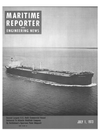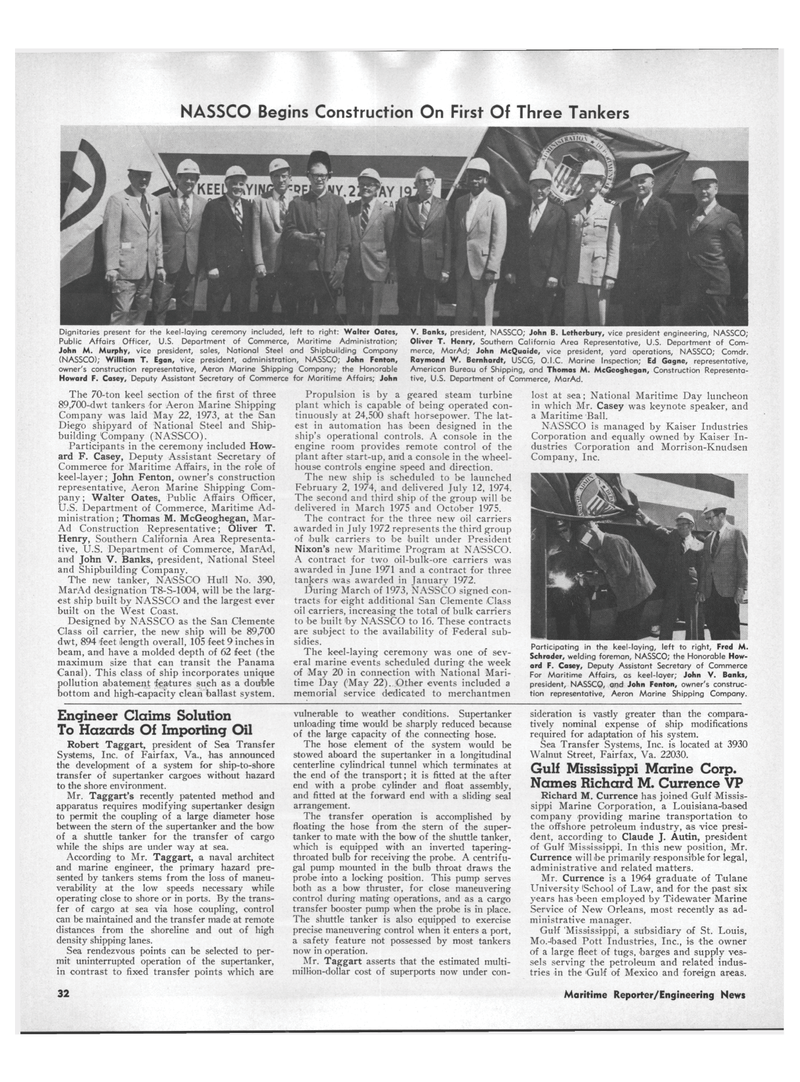
Page 30: of Maritime Reporter Magazine (July 1973)
Read this page in Pdf, Flash or Html5 edition of July 1973 Maritime Reporter Magazine
NASSCO Begins Construction On First Of Three Tankers
Dignitaries present for the keel-laying ceremony included, left to right: Walter Oates,
Public Affairs Officer, U.S. Department of Commerce, Maritime Administration;
John M. Murphy, vice president, sales, National Steel and Shipbuilding Company (NASSCO); William T. Egan, vice president, administration, NASSCO; John Fenton, owner's construction representative, Aeron Marine Shipping Company; the Honorable
Howard F. Casey, Deputy Assistant Secretary of Commerce for Maritime Affairs; John
The 70-ton keel section of the first of three 89,700-dwt tankers for Aeron Marine Shipping
Company was laid May 22, 1973, at the San
Diego shipyard of National Steel and Ship- building Company (NASSCO).
Participants in the ceremony included How- ard F. Casey, Deputy Assistant Secretary of
Commerce for Maritime Affairs, in the role of keel-layer; John Fenton, owner's construction representative, Aeron Marine Shipping Com- pany; Walter Oates, Public Affairs Officer,
U.S. Department of Commerce, Maritime Ad- ministration ; Thomas M. McGeoghegan, Mar-
Ad Construction Representative; Oliver T.
Henry, Southern California Area Representa- tive, U.S. Department of Commerce, MarAd, and John V. Banks, president, National Steel and Shipbuilding Company.
The new tanker, NASSCO Hull No. 390,
MarAd designation T8-S-1004, will be the larg- est ship built by NASSCO and the largest ever built on the West Coast.
Designed by NASSCO as the San Clemente
Class oil carrier, the new ship will be 89,700 dwt, 894 feet length overall, 105 feet 9 inches in beam, and have a molded depth of 62 feet (the maximum size that can transit the Panama
Canal). This class of ship incorporates unique pollution abatement features such as a double bottom and high-capacity clean ballast system.
Propulsion is by a geared steam turbine plant which is capable of being operated con- tinuously at 24,500 shaft horsepower. The lat- est in automation has been designed in the ship's operational controls. A console in the engine room provides remote control of the plant after start-up, and a console in the wheel- house controls engine speed and direction.
The new ship is scheduled to be launched
February 2, 1974, and delivered July 12, 1974.
The second and third ship of the group will be delivered in March 1975 and October 1975.
The contract for the three new oil carriers awarded in July 1972 represents the third group of bulk carriers to be built under President
Nixon's new Maritime Program at NASSCO.
A contract for two oil-bulk-ore carriers was awarded in June 1971 and a contract for three tankers was awarded in January 1972.
Enuring March of 1973, NASSCO signed con- tracts for eight additional San Clemente Class oil carriers, increasing the total of bulk carriers to be built by NASSCO to 16. These contracts are subject to the availability of Federal sub- sidies.
The keel-laying ceremony was one of sev- eral marine events scheduled during the week of May 20 in connection with National Mari- time Day (May 22). Other events included a memorial service dedicated to merchantmen
V. Banks, president, NASSCO; John B. Letherbury, vice president engineering, NASSCO;
Oliver T. Henry, Southern California Area Representative, U.S. Department of Com- merce, MarAd; John McQuaide, vice president, yard operations, NASSCO; Comdr.
Raymond W. Bernhardt, USCG, O.I.C. Marine Inspection; Ed Gagne, representative,
American Bureau of Shipping, and Thomas M. McGeoghegan, Construction Representa- tive, U.S. Department of Commerce, MarAd. lost at sea; National Maritime Day luncheon in which Mr. Casey was keynote speaker, and a Maritime Ball.
NASSCO is managed by Kaiser Industries
Corporation and equally owned by Kaiser In- dustries Corporation and Morrison-Knudsen
Company, Inc.
Participating in the keel-laying, left to right, Fred M.
Schroder, welding foreman, NASSCO; the Honorable How- ard F. Casey, Deputy Assistant Secretary of Commerce
For Maritime Affairs, as keel-layer; John V. Banks, president, NASSCO, and John Fenton, owner's construc- tion representative, Aeron Marine Shipping Company.
Engineer Claims Solution
To Hazards Of Importing Oil
Robert Taggart, president of Sea Transfer
Systems, Inc. of Fairfax, Va., has announced the development of a system for ship-to-shore transfer of supertanker cargoes without hazard to the shore environment.
Mr. Taggart's recently patented method and apparatus requires modifying supertanker design to permit the coupling of a large diameter hose between the stern of the supertanker and the bow of a shuttle tanker for the transfer of cargo while the ships are under way at sea.
According to Mr. Taggart, a naval architect and marine engineer, the primary hazard pre- sented by tankers stems from the loss of maneu- verability at the low speeds necessary while operating close to shore or in ports. By the trans- fer of cargo at sea via hose coupling, control can be maintained and the transfer made at remote distances from the shoreline and out of high density shipping lanes.
Sea rendezvous points can be selected to per- mit uninterrupted operation of the supertanker, in contrast to fixed transfer points which are vulnerable to weather conditions. Supertanker unloading time would be sharply reduced because of the large capacity of the connecting hose.
The hose element of the system would be stowed aboard the supertanker in a longitudinal centerline cylindrical tunnel which terminates at the end of the transport; it is fitted at the after end with a probe cylinder and float assembly, and fitted at the forward end with a sliding seal arrangement.
The transfer operation is accomplished by floating the hose from the stern of the super- tanker to mate with the bow of the shuttle tanker, which is equipped with an inverted tapering- throated bulb for receiving the probe. A centrifu- gal pump mounted in the bulb throat draws the probe into a locking position. This pump serves both as a bow thruster, for close maneuvering control during mating operations, and as a cargo transfer booster pump when the probe is in place.
The shuttle tanker is also equipped to exercise precise maneuvering control when it enters a port, a safety feature not possessed by most tankers now in operation.
Mr. Taggart asserts that the estimated multi- million-dollar cost of superports now under con- sideration is vastly greater than the compara- tively nominal expense of ship modifications required for adaptation of his system.
Sea Transfer Systems, Inc. is located at 3930
Walnut Street, Fairfax, Va. 22030.
Gulf Mississippi Marine Corp.
Names Richard M. Currence VP
Richard M. Currence has joined Gulf Missis- sippi Marine Corporation, a Louisiana-based company providing marine transportation to the offshore petroleum industry, as vice presi- dent, according to Claude J. Autin, president of Gulf Mississippi. In this new position, Mr.
Currence will be primarily responsible for legal, administrative and related matters.
Mr. Currence is a 1964 graduate of Tulane
University ISchool of Law, and for the past six years has 'been employed by Tidewater Marine
Service of New Orleans, most recently as ad- ministrative manager.
Gulf Mississippi, a subsidiary of St. Louis,
Mo.Jbased Pott Industries, Inc., is the owner of a large fleet of tugs, barges and supply ves- sels serving the petroleum and related indus- tries in the Gulf of Mexico and foreign areas. 32 > Maritime Reporter/Engineering News

 29
29

 31
31
